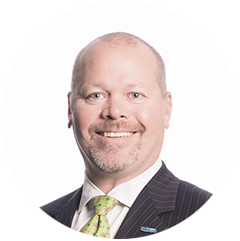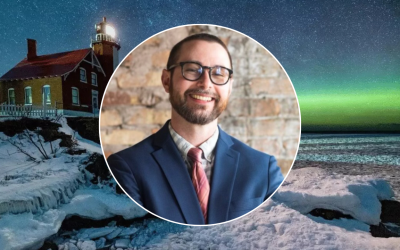The American “Sunshine State” of Florida has a vision to be the world’s #1 travel destination. Ambitious? Definitely. But VISIT FLORIDA has earned its fifth-straight record-setting year of visitation and the growth continues in 2016. A focus on increasing referrals from friends and family plays a key role in topping last year’s 106 million visitors as this destination marketing organization (DMO) responds to today’s challenges by enabling visitors and consumers to be its best promoters.
As part of our Leading Thinkers series (featuring the insights of those who participated in discussions at Destination Think Forum 2016, we asked Will Seccombe, President & CEO of VISIT FLORIDA, to explain his organization’s key challenges and solutions around word-of-mouth promotion.
Destination Think: How are you involving Florida’s residents and tourism community in your marketing activities? How do you think they help to tell your destination’s story?
Will Seccombe: Eight years ago, we launched a campaign called “Share a Little Sunshine”. The idea at the time was that since we know every 85 visitors to the state create a job, if we could engage residents to invite their friends and family to Florida, we could have a very real, positive economic impact, grow bonds between people and create more jobs.
The campaign, which was incredibly successful at the time, was all about encouraging people to invite friends and family to Florida. In more recent years, with the advent of social media, the program has evolved to be a massive advocacy platform that allows Floridians to brag.
“Share a Little Sunshine” has become “#LoveFL”, which encourages Floridians to share what they love most about the state and include the hashtag in their social media postings. With more than a million images shared by Florida fans to date, the campaign we created to promote it is now made up of 100% user-generated content.
This effort has become a great self-fulfilling prophecy. The incredible imagery that Floridians are sharing is helping to promote the state to their friends and family, and we’re then able to curate that content on our website for other people from outside the state to see.
We’re really focusing on social and mobile engagement. I think that in today’s environment, where people trust friends and family, social influencers and often perfect strangers’ opinions more than they trust marketers’ opinions, it’s clearly the way we’re headed.
As you emphasize word-of-mouth referrals, have you experienced any challenges?
We’re fortunate to have had “Share a Little Sunshine” in place for eight years and to slowly build awareness of the program and engagement by our industry partners to leverage it. Over time, we’ve been able to create really impactful campaigns. It has taken time and it’s something we’ve focused extremely hard on for our in-state audience.
As tourism promotion is shifting into the hands of the consumers, what do you think the biggest opportunities are for destinations today?
The biggest opportunities are around engaging your residents to brag about what they love most. As a kid, I remember next-door neighbours coming home and showing us slideshows of their family vacation. That same concept happens today; it just happens in real time on Facebook, Twitter and Instagram. As we’re able to get our industry more engaged, visitation is going up. We’ll have more than 106 million out-of-state and international visitors to Florida this year. That’s up from 82 million just five years ago. So, we’ve got 24 million more people out there sharing what they love about Florida. That’s building incredible momentum.
As proud as I am of the marketing and advertising that VISIT FLORIDA does, there’s never going to be anything more powerful than engaging our industry and our visitors to brag on Florida’s tourism product.
Do you have any advice for other destinations who also seek to improve word-of-mouth promotion?
As we continue with the #LoveFL campaign, we recognize that the world is changing very, very quickly. Who do people trust? They trust friends and family, they trust people they don’t even know and they trust influencers, so we’ve modified our content publishing program. We used to have our own VISIT FLORIDA Insiders and now we’re tapping into influencers that are creating content for us who already have an established audience. This allows great articles and videos to live not only on VISITFLORIDA.com and our social channels, but also on the influencers’ social channels, which broadens the reach significantly.
We also have celebrity influencers who have bought into the program. Our Pitbull relationship is a great example. He just released a new music video filled with Florida imagery that received more than 3 million views in the first week. His audience – the people who follow Pitbull – are now going to see that Florida is cool and exciting, and it’s not just the place where your grandparents went to retire.
We also have a relationship with Ricky Carmichael, the motocross champ. He’s creating content for us, conquering Florida, showing the unique adventure experiences that are available here. He is a trusted, authentic Floridian who is able to tell that story in a very applicable way to his audience. This winning formula works incredibly well, from the big guys like Pitbull and Ricky to niche bloggers and influencers across the spectrum.
Speaking of niches, Florida has so many tourism products to offer. How do you juggle all of the different brands, products and priorities?
I’m a firm believer that trying to be all things to all people – arts, culture, shopping, dining, fun for the whole family – that era of tourism marketing is over. The message is too easily watered down and not believable. With a destination as diverse as Florida, that really becomes a challenge, but has also been our biggest opportunity. Our content team is working with professional writers, photographers, and videographers to capture those untold stories of what is so engaging and unique about a Florida vacation.
In fairness, there are only so many times you can write about Disney, Universal Studios, or SeaWorld. There are only so many times you can write about the beach experience. So, in addition to those flagship experiences, a lot of our content focuses on the distinctive cultural aspects of Florida vacations. Most recently, we’ve added 360-degree videos and other amazing things into the mix, but for it to have a real impact on visitors, we’ve got to be dedicated to it.

Image credit: VISIT FLORIDA
How do you think the role of the DMO will shift over the next five years?
I think it’s all going to be about how well you’re able to demonstrate that you’re creating and adding value to the industry, and that you’re able to deliver a significant return on investment for your community. That isn’t going to change, but I think the value-add proposition probably is.
I remember my first job in a DMO, when I was Vice President of Marketing at the Denver Convention Bureau in the mid to late 90s. Some of the most valuable assets the marketing team had on day one were the original slides of the great images of Denver and the business listings that fueled the visitors guide. Those were the assets that you had. Today, a listing on a website or in a magazine or a visitor guide isn’t as valuable. You’ve got Google, you’ve got Google Maps. It’s a similar story with imagery – anyone can now get those images.
So what is the value add for the destination? How are you able to demonstrate that you’re moving the needle and creating value for your constituents and your partners in the community?
That value add is going to change and differ and can be successful in many different iterations. But, I think it’s clearly identifying it, articulating it and executing a solid value-add proposition to the community.
How can DMOs actively adapt to new needs that come up?
One important question for today is, how can you get your industry all working together? One of the challenges in the tourism industry, wherever you are, is communication. Robert Skrob, Executive Director of the Florida Association of Destination Marketing Organizations, once told me that our business is about leading a parade, not speaking to an audience. You have to consistently communicate what you’re doing, why you’re doing it and how partners can get involved and leverage it.
At the end of the day in this new world, it’s not about a pretty ad or a solid sales effort, it’s about getting as many voices in unity behind a message as possible.
As you work toward uniting your community, how will your strategy change over the next five years as compared to the past five years?
We’ve been incredibly successful with five consecutive years of record visitation from international and out-of-state visitors, and we should celebrate that fact. But, the reality is that if we continue to use the same marketing tools and strategies that have worked for us in the past – just replicating that for the next five years, we won’t be successful and we’ll fall behind the curve. We are continually addressing that – what does our future look like, what’s important to the state, what is the opportunity that VISIT FLORIDA can create?
We’ve got a state full of very smart destination marketers in local communities, so we have the added challenge of creating programs that leverage that and allow them to communicate their unique selling propositions.
We’re also focusing more on maximizing the economic impact of tourism, rather than just the visitor numbers. It’s not as much about how many people we get, but about what the economic impact of those visits are. We know that our international visitors stay longer and spend more, so we’re increasing our focus on growing international visitation.
We’re also focusing on seasonality gaps and how we’re able to bring visitors to areas of the state when we need them. That way, we can start to increase the economic impact without having to increase infrastructure to handle more visitors. That’s a big component – getting people off the beaten path to go exploring communities around the state. For example, getting people to visit a state park or go to a museum on their way from Atlanta to Orlando. Getting them to take the back roads and visit the downtowns of the rural areas of the state. The economic impact of that is massive.
Clearly, another priority is focusing on influencers to help us share our story. These could be Floridians, “LoveFL” fans, our ambassadors, or our content influencers that include travel writers, bloggers, YouTubers and Instagrammers. It doesn’t have to be about VISIT FLORIDA, it has to be about visiting Florida. It’s much less about our brand than it is about our product.
If there is one question you would like to walk away from Destination Think Forum having solved collectively, what would it be?
I’m not sure, but the tea leaves I’m looking at have an awful lot of variables in play for tourism right now. I think any sense of what other people are saying would be valuable to hear.
Gain more valuable insights from speakers, panelists and participants from Destination Think Forum, where the world’s leading destination marketers gathered to address their greatest challenges. Read more interviews with Forum’s Leading Thinkers.
Featured image credit: VISIT FLORIDA












0 Comments